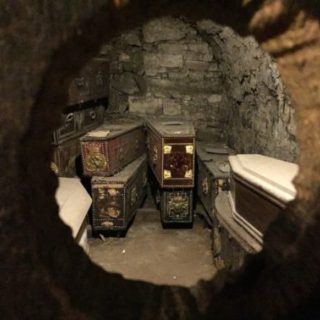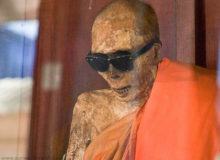Dr. Jamil and Twin Doctors TV visit the ancient and mystical Newgrange megalith of the Boyne Valley along with the little known legendary mummies of Dublin’s St. Michan’s Church.
People, I am not only a Doctor; I am an OB/Gyn Doctor!! That means that I deliver babies for a living, and so as a result, I have no internal body clock to speak of. After all, an internal body clock would only serve to slow me down. It would function to make me less effective at what I do because, after all, ready or not, babies come when babies want to come. And when babies are coming, well God bless those precious little nocturnal angels, they don’t care whether or not it is 2PM or 2AM. They don’t care if you’re tired, and they most certainly don’t care whether or not you’ve had enough sleep. So, over the years I’ve developed the ability to endure extreme sleep deprivation while still being able to function and carry on normal day to day activities. Trust me when I tell you that this little skill of mine often times comes in handy when I’m travelling. Now if you’re wondering exactly how I am able to endure extreme sleep deprivation and still maintain my ability to function, it is simple. Some years back I took the unusual step of torching my body clock.
That’s right folks, you heard me correctly. A number of years ago I made the difficult, life altering decision to torch my body clock. And let me tell you. After making the decision to torch my body clock, I never looked back. I just ripped that sucker right out of my body, and then in a moment of absolute catharsis, I set it asunder! I incinerated it! And in doing so, I freed myself from it’s clutches and from the unrealistic expectations for rest that it placed upon me. You too my dear friends could do the same thing of course, that is if you knew where your body clock was located. I being a Doctor who has removed his own body clock could of course tell you where yours was located, but as a board certified OB/Gyne physician, I have been sworn to secrecy by both The American College of Obstetrics and Gynecology and by The American Medical Association. So for me to break my silence and to reveal the secret location of the human body clock would be akin to professional suicide. So friends I’m sorry, but the secret of the body clock’s location must remain just that, a secret. This all being said, because I don’t have a body clock anymore, after just a few hours of sleep I woke up bright early at 6:30AM to begin my second day in Ireland. You can read more here about The Twin Doctors Travel Bag’s Heritage Tour and about my first day back home in one of our ancestral homelands, Ireland.

My burning body clock
Boyne Valley Complex (Brugh na Boinne)
After breakfast I quickly located Damian, my private tour guide for the morning, as he waited for me in the hotel lobby. Together we quickly made our way to his waiting car, hoping to hit the M1 motorway ahead of Dublin rush hour traffic for the 40 minute drive north to Ireland’s Boyne Valley region. Within the Boyne Valley region of Ireland is the Boyne Valley Complex (Brugh na Boinne), a UNESCO (United Nations Educational, Scientific and Cultural Organization) World Heritage Site. The complex is one of Europe’s oldest megalithic sites, having been built approximately 3200 years before the birth of Christ. In fact, the Boyne Valley Complex even predates the pyramids of Egypt and England’s Stonehenge. A megalith is a large stone, or a large stone structure, that forms all or part of a prehistoric monument. The Boyne Valley Complex is comprised of three main “passage mound” megaliths. A passage mound megalith is a large megalithic mound that is built above ground, and that has a passage way that passes through it. The three passage mound megaliths of the Boyne Valley Complex are named Newgrange, Knowth and Dowth. On our journey to the Boyne Valley, we would be making our way north to the Newgrange passage mound. Some of Ireland’s passage mounds are thought to have been used as tombs, while others are thought to have been used for religious observances and ceremonies. Some of Ireland’s passage mounds are thought to have been used for a multitude of functions, though in reality, no one can be completely sure of why many of these megalithic passage mounds were built, or what functions they truly served. What we do know with certainty however is that the megalithic passage mounds of the Boyne Valley Complex were built and oriented in such a way that they can accurately measure the earth’s lunar and solar cycles.
The Newgrange megalith is a large round passage mound that is composed of white quartz and granite. The quartz and granite used to build Newgrange is thought to have come from the Wicklow region of Ireland. Wicklow is about 60 miles south of the Boyne Valley. It is thought that the ancient builders of Newgrange brought the large stones used in its construction, some of which remarkably weighed 5 tons or more, up to the Boyne Valley from Wicklow by way of the Atlantic Ocean and the Boyne River. Many believe that this must have been the route that the stones took in large part because Newgrange was built many years before the wheel had been invented. So without the aid of wheels to help move the large stones across land, the only other conceivable method of transporting them involved “floating” them up to the Boyne Valley from Wicklow.
Most experts estimate that it took anywhere from 20 to 60 years for builders to complete the construction of the Newgrange passage mound. Today, the passage mound stands 39 feet high and 249 feet across. The entrance to the megalith is located along the southeast side of the structure. Beyond this entrance sits a passage way. The passage way, which is lined by large stone slabs, is approximately 60 feet long. It leads to a central chamber that is itself then surrounded by three smaller chambers. The passage way, while easy to walk, does at times become very narrow along its path to the central chamber. For 364 days a year, the central and surrounding chambers sit in almost total darkness. But once a year, for only 17 minutes on the day of the Winter Solstice, the passage mound’s normally very dark central and surrounding chambers becomes awash with sunlight. As it is on the Winter Solstice, during these 17 minutes, that the sun sits in the perfect position in the sky to allow it’s light to pass through a window-like structure above Newgrange’s entrance. Passing through this window-like structure, the proper name of which is a “roof-box”, the sunlight then illuminates Newgrange’s central and surrounding chambers. Now exactely why the Newgrange passage mound was constructed and oriented in such a way as to mark the Winter Solstice by allowing sun light to completely fill it’s central and surrounding chambers for those 17 minutes is unclear. And therein actually lies one of the megalith’s great mysteries.
Surrounding the perimeter of the Newgrange passage mound are smaller megalithic stones called Kerbstones. These kerbstones have a variety of images and shapes carved into their surfaces including spirals, circles, chevrons and arcs. Some Archaeologists believe that the Kerbstones surrounding Newgrange served nothing more than a simply decorative purpose. Others believe that they served either a symbolic or a ceremonial purpose. Yet others believe that the kerbstones, and the designs contained within the kerbstones, have some sort of astronomical significance. Again, no one really knows? And that after all is part of the beauty of Newgrange. Everything about it, from why it was built to what it was used for is still a mystery.
Traffic along the M1 motorway leading out of Dublin was light, and with Damian at the wheel, we reached the Newgrange Visitors Center well before 9AM. This was significant because the first bus from the visitors center to the Newgrange passage mound leaves at 9AM. Arriving before the first bus was due to leave the visitors center meant that Damian and I had a few moments to grab some coffee and to sit down for a chat. While drinking our coffee Damien, with a slight giggle, pointed out a number of cars being driven by what he called “tourists”, people who were attempting to drive directly from the motorway to the Newgrange passage mound. “You see there” he said while pointing to the stream of arriving vehicles. “These people are tourists. They all put ‘Newgrange’ into their GPS’, not knowing that doing that would prompt the GPS’ to try to lead them directly to the Megalith”. “However” he continued, “you can’t drive directly to the megalith”. And so when the cars being driven by these “tourists” tried to approach the megalith, they encountered barriers that prevented them from actually getting anywhere close to the structure. Once at these barriers, they also encountered guards who quickly would turn them back around. The sight of these cars coming one after the other on a futile mission made us both laugh I must confess. Though I also must confess that before choosing to enlist Damian to be my guide for the morning, I gave some thought to renting a car and making my way to Newgrange myself. Had I done so, I have no doubt that I would have suffered the same fate as the rest of these “tourists”. Damian then shared that “what these tourists should have done was to put ‘Brugh na Boinne’ into their GPS units”. Brugh na Boinne, the local Gaelic term used to refer to the Newgrange passage mound means “palace” or “mansion”. When “Brugh na Boinne” rather than “Newgrange” is put into a GPS unit, that unit will direct visitors to the visitors center rather than trying to take them directly to the megalith. Something to keep in mind if you ever decide to make an independent journey to the Newgrange passage mound.
While Damian and I shared a hearty chuckle at the expense of these “tourists”, their innocent mistakes, and the delays that resulted from these mistakes could have cost them big. That is because, in an effort to preserve the Newgrange megalithic site for generations to come, the Irish government actually limits the number of visitors admitted to the site each day. They only allow 600 people each day to walk the grounds of Newgrange, so if you get confused while trying to make your way there, if you get turned around, or if you just get there too late, you could just find yourself out of luck. Having been an “Independent Traveler”, and thanks to a top notch guide in Damian, I was among the first 16 people to reach Newgrange on the day of my visit. This meant that I had unparalleled access to the megalith, unfettered views of the grounds and that I was able to comfortably go into the passage mound itself without fighting with the crowds. Hey, the early bird catches the worm. Here’s to having no body clock!!
After a quick bus ride from the visitors center to the Newgrange passage mound site, the first thing that struck me was just how fresh the air around the megalith smelled. With dew permeating the atmosphere, and with miles and miles of rolling grass and flower filled pastures surrounding the megalith, the air had a moist and sweet quality to it. It was also because of this visible moisture in the air that the early morning sun’s rays, while passing through the atmosphere, frequently would create these almost ethereal appearing beams of light. Adding to the general sense of peace and calm surrounding the megalith was the fact that the area surrounding the passage mound was also very, very quiet. In fact, the stillness of the morning air was only occasionally broken by the sounds of birds chirping and flapping their wings as they flew past the megalith and the megalith’s first visitors of the day. The sights, sounds (or lack thereof) and smells of Newgrange really combined to create this almost other worldly feel, and while walking the grounds of one of the world’s oldest megaliths, I instantly knew that I was somewhere that was both unique and special. At Newgrange, it felt almost as if time was standing still. Or better yet, it felt almost as if time didn’t even exist. As if yesterday, today and tomorrow were all inexplicably sharing this one common space. I don’t know how else to describe the feeling that I felt at Newgrange, how else to describe the vibe of the site, other than to say that I felt this very strange sense of oneness with the universe while at Newgrange. Like there was no past, no present and no future; but instead just this shared universal existence within which time really didn’t exist. I know that this may sound weird to some people, but I really don’t know how else to describe what I felt at Newgrange. Somethings I guess may just have to be experienced, experienced at just the right time, under just the right conditions and with just the right mindset to really be understood.
Why did I feel the way that I felt at Newgrange? Well some Archaeologists and some Neuroscientists have a theory. They theorize that the orientation and the structural acoustics of the Boyne Valley passage mounds, as well as their surrounding megaliths, were constructed in such a way as to actually affect how certain parts of the human brain function. An odd theory when first entertained, but believe it or not there is actually quite a bit of very legitimate scientific research that lends some validity to this possibly. A number of well vetted studies have found that sounds of certain frequencies, typically those sounds within the 110 Hertz range, can affect certain human brain functions. Particularly those functions involving the brain’s frontal and prefrontal regions. These are the regions of the brain that control our abstract thinking, judgment, problem solving, memory, emotions and our ability to concentrate. So maybe the inexplicable feelings felt while at Newgrange, and maybe the way in which we process the things that we see and the smells that we smell while at Newgrange are in part the result of how the site’s acoustics affect our brain. Now, I do know that the air at Newgrange did smell just a little bit sweeter than normal to me. And I also know that the sun’s rays looked just a little bit brighter, more radiant and ethereal to me at Newgrange. I also know that everything that I perceived while at Newgrange, the sights, the sounds, the smells, they all felt very real to me. But were these perceptions actually real, or were they just a product of how the site’s orientation and structural acoustics affected my brain’s frontal and prefrontal regions? I don’t know the answer to that question, and even if I did know the answer, I don’t know that I would share it. Newgrange is after all a magical place, and that is really all that I care about. What makes it magical, well that is for each individual visitor to the site to decide for themselves?
Regardless of what the source of Newgrange’s magic might be, as a Doctor, I do find it exciting to consider that some of Newgrange’s “magic”, and the knowledge possibly gained from studying this “magic”, could one day be put to good medical use. Consider the fact that research has shown that the use of a series of short syllables, when sung or chanted in a repetitive manner around megaliths like Newgrange, possibly again taking advantage of the unique structural acoustic properties of these megaliths, can produce sounds in that 110 Hertz range. Like I also said earlier, sounds in that 110 Hertz range have been shown to have the ability to alter how our brain’s frontal and prefrontal regions function. In doing this, some believe that these sounds when created by chanting or singing, may not only affect our abstract thinking, judgment, problem solving abilities, memory, emotions and our ability to concentrate; but that they may also help to reduce our feelings of stress while promoting a deeper sense of overall euphoria and well-being. And together, some scientists theorize that all of the effects created by altering the frontal and prefrontal regions can in turn help to promote a healthier, better functioning immune system. Promoting a healthier, better functioning immune system of course would in turn then promote better overall physical and mental health. Whoa, now that was a mouth full!!! But it may very well be that the ancients who constructed megaliths like those in the Boyne Valley Complex, Stonehenge in England, Kilmartin in Scotland, the Hypogeum in Malta, the Chichen Itza in Mexico and Adam’s Calendar in South Africa knew something about the “magic” and about the healing properties of sound and architectural acoustics. Something that we are just starting to relearn here in modern times.
After meandering around the outside of the Newgrange passage mound for 15 minutes or so, a local tour guide arrived and shared some of the history of the site with the 16 of us that arrived on the first bus of the day. She then took us into the passage mound, allowing us to enter through the megalith’s southeast entrance. The passage way leading from the entrance to the passage mound’s central chamber becoming very narrow at certain points led the guide to warn that anyone who was claustrophobic should be among the last to enter the passage way. That way, if things became too cramped for them, they could just turn around if need be, and make a quick exit. Once through the passage way, we reached the megalith’s central chamber. Today the passage mound has been wired to provide for some artificial lighting, so use of this lighting made negotiating the passage way and the chamber itself fairly easy. Once in the central chamber, and after giving us fair warning, the guide turned off all of the artificial lighting. This plunged the passage mound into complete and total darkness. Then, to recreate the megalith’s Winter Solstice effect, a small beam of light initially appeared close to the megalith’s entrance. This light then slowly moved up the passage way just as it would on the day of the Winter Solstice before it finally entered and then completely illuminated the passage mound’s central chamber. As I viewed this artificial recreation of Newgrange’s Winter Solstice effect, I found myself thinking “God I wish I could be here during the actual Winter Solstice” so that I could really experience that magical 17 minutes.
Now if you ever want a truly unique Newgrange experience, the Newgrange experience that I was lusting after while watching the artificial lighting of the passage mound during my visit to the megalith, then you should consider entering the “Newgrange Winter Solstice Lottery”. The Newgrange Winter Solstice Lottery is held annually, and the 50 winners of the lottery are granted access to the passage mound’s central chamber in the days leading up to and during the Winter Solstice. This year 30,574 people entered the lottery, and as luck would have it, the day of my visit to Newgrange was the day of the lottery drawing. So when I returned from the passage mound to the Newgrange Visitors Center, I found a local news crew there televising the lottery drawing. The drawing included 50 middle school students, each of whom took a turn pulling the names of the lucky 50 lottery winners from the pile of the 30,574 people who had entered. Being curious I watched the proceedings for a while, felt a little bit jealous of the winners as each of their names were pulled from the entrant’s pile and then left, making my way back with Damian at the wheel back to Dublin. Once in Dublin, he dropped me off at St. Michan’s Church. Now folks let me tell you, St. Michan’s is like no other church you’ve likely ever visited before. And for some, it’s probably like no other church they’ll ever want to visit again.
St. Michan’s Church
Prior to the year 795, the population of Ireland was uniformly Celtic. However in the year 795 the Vikings arrived in Ireland. The word Viking loosely translated means “sea roving pirate”, and this is exactly what the Vikings were. Forced from their original homeland of present day Sweden, Norway and Denmark by rampant overcrowding and resulting shortages of fertile land, these farmers, fisherman and sea merchants set out in search of literal and proverbial greener pastures. Unfortunately for the Celtic people inhabiting Ireland, the Vikings found these greener pastures in Ireland. The city of Dublin, originally named “Dubh Linn” or “Black Pool” was founded by Danish Vikings. Dubh Linn was named after the lake where the Danish Vikings first secured their boats after arriving to Ireland. While under Viking control, Dublin was the site of a great deal of strive between Vikings from present day Norway and Vikings from present day Denmark. They fought one and other for control of the city of Dublin and ultimately in the year 852, the Danish Vikings wrested control of Dublin away from the Norwegian Vikings. With this, they established the “Danish Kingdom of Dublin” which they then continued to control for close to 300 years. Eventually however Anglo-Normans from England arrived in Ireland. With their arrival they expelled the Danish Vikings from what were then Dublin city limits. And in the year 1095, St. Michan’s Church was built to serve this Danish Viking community that had been expelled from Dublin city limits by the Anglo-Normans. In the year 1685 St. Michan’s was rebuilt and in the year 1998 it was restored.
Today St. Michan’s Church is under the control of the Protestant Church of Ireland. It can be found north of the River Liffey, on the aptly enough named Church Street. The interior of St. Michan’s is simple in many respects and yet ornate in others. When you first enter the church’s chapel and survey the space, at eye level, it basically looks like just about any other random church chapel. There are pews and a few fairly run of the mill stained glass windows. But then when you take a gander upwards, your eyes are drawn almost immediately to some stunningly beautiful deep reddish brown appearing cherry woodwork. This rich woodwork surrounds the entire chapel. Surveying further, your eyes are next drawn to a large organ made of brass and wood that is adorned with the faces of baby angels. I didn’t have an opportunity to hear the organ play during my visit to St. Michan’s, but those powerful pipes look like they could put out some deep and resonating sounds. A look further around the church’s chapel also reveals a “Penitent’s Stool”. This stool sits just adjacent to the church altar. St. Michan’s Penitent’s Stool is reportedly the only such stool remaining in any church in Ireland. It was used to publically shame church congregants who were accused of behavior that was in conflict with the teachings of the church. The accused were made to sit on this stool during church services as a way of publically acknowledging their transgressions while simultaneously silently asking for forgiveness.
While St. Michan’s church chapel is in some ways simple and in other ways ornate, and while the church itself has a rich and unique history that is to be celebrated; the highlight of any visit the church is not the actual sanctuary itself. Instead, the highlight of any visit to St. Michan’s are the crypts and the burial vaults that lie beneath the church’s sanctuary. Lined by limestone walls, these burial vaults have a remarkably dry atmosphere that has created a very hospitable environment that has served to preserve the centuries-old bodies interred within. Among the corpses contained within the various burial vaults beneath the church are the body of a nun, the body of a man who is missing both of his feet and one of his hands (thought by some to have been the result of a punishment for stealing) and the body of a tall Crusader. The legs of the Crusader, who at the time of his death stood well over 6 feet tall, making him a veritable giant in his time, were broken and tucked beneath him to ensure that his body would actually fit into his coffin. Collectively these three, the Nun, the Crusader and the suspected Thief are frequently referred to as “The St. Michan’s Mummies”. Their bodies however are not the only bodies contained within the St. Michan’s crypts. In fact, there are many burial vaults beneath St. Michan’s Church that contain the coffins, and presumably the bodies, of some of Dublin’s former citizens. In fact, a few of the burial vaults beneath St. Michan’s Church are still categorized as being “active” burial vaults. “Active” burial vaults at St. Michan’s Church are those vaults owned by families with family members who are still living, and who still lay official “claim” to their family’s burial vault. These people, as a result of their claims to their family’s burial vaults, still have the right to have their body’s interred within these vaults upon their deaths. While the “active” burial vaults can still technically be used to inter the dead, the last remains actually interred within a St. Michan vault were placed there in the late 1960’s. Nonetheless, it is part of St. Michan’s tradition that the lighting that has been placed within each of the burial vaults never be turned on in the “active” vaults. The active vaults therefore always remain dark, while the lights can be, and often times are turned on in the inactive burial vaults. While it is assumed that most, if not all of the bodies interred within the St. Michan’s burial vaults have been mummified as a result of the hospitable environment created by the vaults surrounding limestone walls, it is, as governed by Section 46 of the “Local Government Sanitary Services Act of 1948”, illegal to exhume interred remains in Ireland, except under very strict circumstances, and only after the appropriate governmental authorization has been requested and granted. And so no one has actually ever looked into the numerous coffins contained within St. Michan’s various active and inactive burial vaults.
When I reached St. Michan’s Church it was just a little after 12 Noon. The outside of the church looked nondescript enough, and I was surprised to find that there was not lines of people waiting to go into the church. In fact, there was very little activity to speak of outside of, or around the church; and for a minute I wondered whether or not I was actually in the right place. It was therefore with a little bit of doubt and hesitation that I made my way to the main entrance of the church and I then opened the doors. Upon entering the building I found myself standing in a foyer. To my left in the foyer was a small glass display case. To the right of this display case was a set of double doors that I presumed led to the church’s chapel.
Directly in front of me was a little office and sitting inside of that little office next to one and other was an elderly man and an elderly woman. They interacted with one and other in a comfortable tongue in cheek sort of manner that made me think that they were either husband and wife, or maybe just long time church parishioners who had known one and other for years. When I walked into the office that they shared I introduced myself and then inquired about touring the church’s burial vaults. They informed me that a tour of the vaults would cost 6 Euros, and after paying the 6 Euros, I was given an informational pamphlet that detailed the history of both the church and its burial vaults. The couple then invited me to take a look around the church’s chapel while they summoned the burial vault’s tour guide. I was probably in the chapel for no longer than 5 minutes before the burial vault’s tour guide came into the chapel to fetch me. Unfortunately, I either didn’t catch his name or he didn’t offer his name. But given the nature of the tour that he was about to take me on, and given the way that he ghoulishly rung his hands together while simultaneously shuffling his feet as he walked, dragging the right foot and leg behind him as if they were nothing more than dead weight, I decided that his name must have been Igor or something else macabre and straight out of a B-rate 1950’s horror film like that. “Igor” seemed to take great delight in building up the suspense as we walked, or should I say as I walked and as he shuffled out of the chapel and towards two sets of storm doors that led underground to the burial vaults. “Who wants to see some mummies” he asked, making sure to draw out the word “m-u-m-m-i-e-s” as he opened the first set of storm doors? “Who is afraid of the dark” he asked, as he led me down the first set of stairs and into the first crypt? The crypt area was of course initially dark, but with the flick of a light switch Igor partially illuminated the space that we were standing in. I say partially illuminated the space because the lighting in the area was pretty sparse. This of course only served to better set the “mood” for touring the burial vault, creating shadows and dark corners, and it made me feel almost immediately as if I had stepped out of reality and into the scene of a horror movie.
St. Michan’s Burial Vaults/St. Michan’s Mummies
The limestone walls surrounding the crypt and the vaults were very jagged and weathered looking, while the ceiling was semi-circular in shape. Taking stock of my surroundings, it was immediately clear to me that the space that Igor and I occupied had been there for many, many years. Being someone who fears spiders, I saw more spider webs hanging from the ceiling than I cared to count. And the gravel floor beneath our feet had a layer of dust on it that must have been at least an inch thick. And then as I looked around I came to a startling realization……. I was the only black guy in the entire damn crypt! And with this realization my heart began to pound, my palms became sweaty and I instantly became filled with an overwhelming sense of dread. After all everyone knows that the black guy at the beginning of a horror movie doesn’t live for more than just a few scenes, unless of course you’re Wesley Snipes in Blade. But I ain’t Wesley Snipes, and to the best of my knowledge at the time I wasn’t in a Blade sequel either!!! So as my reality began to set in I wondered to myself how I could have been so stupid. How did I get myself into this situation? Was my end near? Was I doomed to die in a most unceremonious fashion, to die in a manner befitting only the most bit of bit part horror film actors?
All joking aside though, while I knew that I hadn’t stepped out of reality and into a B-rate horror film, it is said that the burial vaults at St. Michan’s did inspire one of the most famous horror stories the world has ever seen. Bram Stoker, the author of Dracula and a native Dubliner visited the St. Michan’s burial vaults numerous times as a child. He would visit with his Mother and his Grandmother as they paid respect to loved ones buried on the church grounds. It is said that Stoker was quite enamored with the church’s burial crypts and vaults, and that the crypts and vaults served as part of the inspiration for his now legendary Dracula. So as it turns out, the vaults really can be, and have been, the stuff of legendary horror stories.
As I made my way to the back of the first burial vault, I was able to view “The St. Michan’s Mummies”. To the left lay the Nun, next to her was the suspected thief who was missing his feet and his right hand and behind them was the “Giant” Crusader whose legs had been broken and folded beneath him so that his tall frame could fit into his coffin. And then there was a fourth mummy lying to the right of the suspected thief, but I never learned much about the identity of this fourth mummy. The reason that I never learned much about the identity of this fourth mummy, other than the fact that the mummy was female, is because no one knows anything about her. No one knows who she was or why she merited burial in the church’s vault. She is simply referred to by many as “The Unknown”.
After taking a few pictures of the four mummies, Igor asked “would you like to touch a m-u-m-m-y”? “Of course I’d like to touch a m-u-m-m-y” I replied. And so Igor then removed the gate that separated “The St. Michan’s Mummies” vault from the crypt’s passage way. He then allowed me to enter into their space of final rest. After entering, I found that I began to feel a little bit guilty and opportunistic, almost as if I was disrupting their rest and encroaching upon their space just for the sake of my own curiosity. So after entering the vault I said a silent prayer. With the prayer complete I then introduced myself to them by saying “hi guys, I’m Jamil and I’m from the United States”. While standing watchfully outside of the vault Igor then encouraged me to “shake” the Crusader’s hand. He then pointed out the fact that the first two fingers on the Crusaders right hand were missing. Igor said that it was assumed that these fingers were missing as a result of visitors to the vault over the centuries observing the practice of “shaking” the Crusaders right hand for good luck. “Well” I thought to myself as I made my way carefully towards the Crusader’s coffin, “I certainly could use some good luck”. And so I bent down, quietly introduced my presence again with a simple “hello” and then gently rubbed the mummy’s right hand with my right index finger. As I did so, I wondered how a former Crusader would feel about me, a Muslim guy, “shaking” his hand for luck? Not being one for overly divisive religious dogma however, this thought caused me little hesitation. After shaking the Crusader’s hand I then made my way out of the mummy’s vault, down the short passage way and out of the first crypt.
“Igor” then took me to a second burial crypt that was much larger than the first crypt that we had visited. This second crypt, being larger, also contained quite a few more burial vaults than the first crypt did. Some of these vaults were “active” and therefore kept dark, while others were deemed “inactive” and were therefore illuminated. The first inactive vault that I came across after entering the second crypt was the vault of the Sheares brothers. John and Henry Sheares were both lawyers from Cork Ireland who, after a visit to Paris France in 1792, became swept up in all of the anti-British fervor that characterized the then evolving French Revolution. The Sheares brothers enraptured, then returned to Ireland and joined the anti-British “Society of United Irishmen”. When France later declared war on Britain, and by default on Ireland (which was under British control), the anti-British, French sympathizing Society of United Irishman was banned by the British government. Many of the Society of United Irishmen’s members were then jailed. The Sheares brothers however remained free. And while free, they continued to engage in anti-British activities while working in close cooperation with French Revolutionary forces. This ultimately resulted in their arrest, trials and eventual convictions. Their punishments? Well in 1798, the Sheares brothers were hanged, drawn and quartered. To be hanged, drawn and quartered means in effect that each of the brothers was fastened to a wooden slab and drug behind a horse to their ultimate place of execution. At their places of execution each of the brothers were hanged, asphyxiated almost to the point of death. They were then cut free of the ropes around their necks just before they could die. While still alive, but undoubtedly in a great deal of pain, they were then emasculated, subsequently disemboweled and then finally killed when their heads were cut off. Their newly dead bodies were then quartered (chopped into four pieces). All of this was done in public to dissuade others from cooperating with the French. The document framed and displayed in front of their two coffins in their burial vault is believed to be their actual execution order.

 June 15, 2017
June 15, 2017



































 May 19, 2018
May 19, 2018 





